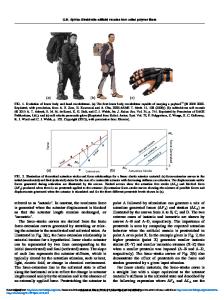Characterization of Fibers Electrospun from Organometallic Tin Precursors in a Polymer Binder
- PDF / 276,900 Bytes
- 6 Pages / 612 x 792 pts (letter) Page_size
- 54 Downloads / 302 Views
0948-B11-05
Characterization of Fibers Electrospun from Organometallic Tin Precursors in a Polymer Binder Christopher Rodd1, and Jorge J. Santiago-AvilÈs2 1 Materials Science and Engineering, University of Pennsylvania, 3231 Walnut Street, Philadelphia, PA, 19104 2 Electrical & Systems Engineering, University of Pennsylvania, 200 South 33rd Street, Philadelphia, PA, 19104 ABSTRACT Electrospinning has been thought of as an effective, low cost technique for producing nanofibers for use in gas sensor applications with nanofibers of tin oxide showing particular promise in this area. Critical to the success of tin oxide in these applications are nanowires with a rutile phase structure and well defined current-voltage characteristics which requires controlled fiber diameters. This paper reports on the characterization of the pre and post sintered fibers deposited via electrospinning of two different tin precursor chemicals, dimethyl dineodecanoate tin and dimethyl dichloro tin, both spun within a polyethylene oxide / chloroform binder system. Both tin precursor systems were evaluated at different concentration levels to investigate morphological changes due to concentration. Mats of fibers were spun on silicon wafers and sintered at 600∫C for 2 hours. Morphology was characterized by optical microscope while chemical composition was determined via Raman spectrometry. Fibers of dimethyl dineodecanoate tin were found be ~30µm in diameter and to have considerable component separation upon deposition. After sintering, SnO2 islands were found but there was no fiber appearance. Fibers of dimethyl dichloro tin were found to be ~10µm in diameter and lacked the component separation seen in the other tin precursor system with some SnO2 domains found directly inline with initial fiber deposition. Comparison of results from both systems shows that the interaction of the polymer and tin precursor is of paramount importance for development of micro- or nanosized ceramic wires deposited by electrospinning. INTRODUCTION Gas sensors based on stannic oxide (tin IV oxide) were first developed by Taguchi in 1962 in Japan with commercialization occurring in 1968.1 As with most sensors, tin oxide sensors operate by measuring the change in the electrical conductance (or resistance) of a tin oxide thin film with changes in the level of gas. This difference in conductance is proportional to the gas concentration raised to an empirically determined power (typically ranging between 0.5 and 0.9). 2 The conductivity change is thought to occur by a depletion region formed by oxygen on the surface of nanometer sized grains of tin oxide. Thus, tin oxide is thought to exhibit characteristics of n-type semiconductors with its donor level being formed by oxygen lattice vacancies. 1 This depletion region also causes a reduction in the potential barrier between grains increasing the hopping mobility and, therefore, the conductance of the film. 2 Current tin oxide
sensors are operated in the 300∞C to 400∞C range to ensure that the sensor can respond rapidly
Data Loading...










